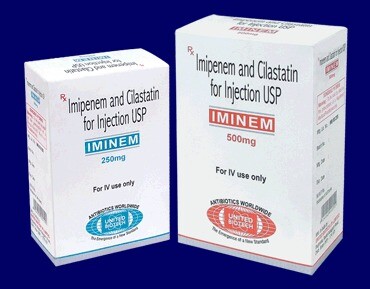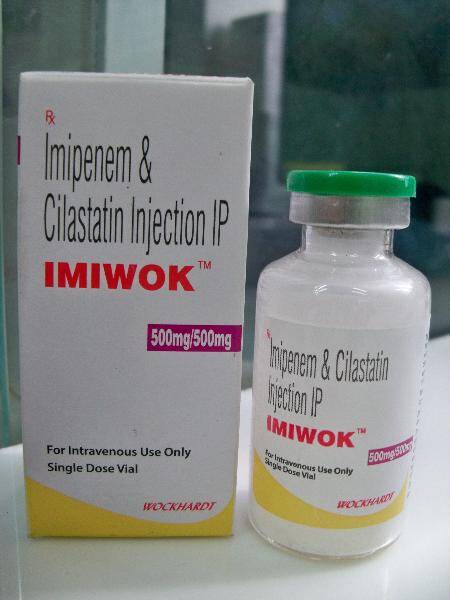Drug Nomenclature
International Nonproprietary Names (INNs) in main languages (French, Latin, Russian, and Spanish):
Description
Imipenem is the N-formimidoyl derivative of thienamycin, an antibiotic produced by Streptomyces cattleya.
Pharmacopoeias
In Europe, Japan, and US. European Pharmacopoeia, 6th ed., 2008 and Supplements 6.1 and 6.2 (Imipenem).
A white, almost white, or pale yellow powder. Sparingly soluble in water; slightly soluble in methyl alcohol. A 0.5% solution in water has a pH of 4.5 to 7.0. Store in airtight containers at a temperature of 2° to 8°.
The United States Pharmacopeia 31, 2008 (Imipenem).
A white to tan-coloured crystalline powder. Sparingly soluble in water; slightly soluble in methyl alcohol. Store at a temperature not exceeding 8°.

Incompatibility and stability
Imipenem is unstable at alkaline or acidic pH and the commercially available injection of imipenem with cilastatin sodium for intravenous use is buffered to provide, when reconstituted, a solution with pH 6.5 to 7.5. Licensed product information advises against mixing with other antibacterials.
Adverse Effects
Imipenem is always given with the enzyme inhibitor cilastatin and thus clinical experience relates to the combination. Adverse effects with imipenem-cilastatin are similar in general to those with other beta lactams (see Benzylpenicillin, and Cefalotin). Hypersensitivity reactions such as skin rashes, urticaria, eosi-nophilia, fever, and, rarely, anapliylaxis may occur. Gastrointestinal effects include nausea, vomiting, diarrhoea, tooth or tongue discoloration, and altered taste. Superinfection with non-susceptible organisms such as Enterococcus faecium, strains of F’seudomonas aeruginosa with acquired resistance, and Candidamay also occur. Pseudomembranous colitis may develop. Erythema multiforme, exfoliative dermatitis, Stevens-Johnson syndrome, and toxic epidermal necrolysis have been reported rarely. Increases in liver enzymes and abnormalities in haematological parameters, including a positive Coombs’ test, have been noted. Local reactions such as pain or thrombophlebitis may occur after injection. Seizures or convulsions have been reported with imipenem-cilastatin, particularly in patients with a history of CNS lesions and/or poor renal function, but sometimes in those without predisposing factors for seizures given recommended doses. Mental disturbances and confusion have also been reported. Cilastatin has protected against the nephrotoxicity seen with high doses of imipenem given experimentally to animals. A harmless reddish coloration of urine has been observed in children.
Hypersensitivity
A retrospective analysis involving a total of 211 patients appeared to show that those with a history of reported or documented penicillin allergy had an 11% incidence of hypersensitivity reactions when treated with a carbapenem antibacterial compared with 2.7% for those without such a history of penicillin allergy. There was no difference in the occurrence of allergic-type reactions between imipenem-cilastatin and meropenem.
Precautions
Imipenem-cilastatin should not be given to patients known to be hypersensitive to it, and should be given with caution to patients known to be hypersensitive to penicillins, cephalosporins, or other beta lactams because of the possibility of cross-sensitivity. It should be given with caution to patients with renal impairment, and the dose reduced appropriately. Particular care is necessary in patients with CNS disorders such as epilepsy.
Interactions
Seizures have been reported in patients given ganciclovir with imipenem-cilastatin.
Antiepileptics
For reports of decreased plasma-valproate concentrations (sometimes with loss of seizure control) attributed to imipenem.
Antimicrobial Action

Imipenem is bactericidal and acts similarly to the penicillins by inhibiting synthesis of the bacterial cell wall. It has a very broad spectrum of activity in vitro, including activity against Gram-positive and Gram-negative aerobic and anaerobic organisms, and is stable to hydrolysis by beta-lactamases produced by most bacterial species. Cilastatin, the enzyme inhibitor given with imipenem, appears to have no antibacterial activity. Most Gram-positive cocci are sensitive to imipenem including most streptococci, and both penicillinase-and non-penicillinase-producing staphylococci, although its activity against meticillin-resistant Staphylococcus aureus is variable. Imipenem has good to moderate activity against Enterococcus faecalis, but most E. faecium are resistant. Nocardia, Rhodococcus, and Listeria spp. are also sensitive. Among Gram-negative bacteria, imipenem is active against many of the Enterobacteriaceae including Citrobacter and Enterobacter spp., Escherichia coli, Klebsiella, Proteus, Providencia, Salmonella, Serratia, Shigella, and Yersinia spp. Its activity against Pseudomonas aeruginosa is similar to that of ceftazidime. Imipenem is also active against Acinetobacter spp. and Campylobacter jejuni, and also against Haemophilus influenzae and Neisseria spp., including beta-lacta-mase-producing strains. Many anaerobic bacteria, including Bacteroides spp., are sensitive to imipenem, but Clostridium difficile is only moderately susceptible. Imipenem is not active against Chlamydia trachoma-tis, Mycoplasma spp., fungi, or viruses. There have been reports of antagonism between imipenem and other beta lactams in vitro. Imipenem and aminoglycosides often act synergistically against some isolates of Ps. aeruginosa. Imipenem is a potent inducer of beta-lactamases of some Gram-negative bacteria, but generally remains stable to them. Acquired resistance has been reported in Ps. aeruginosa during therapy with imipenem.
Pharmacokinetics
Imipenem is not appreciably absorbed from the gastrointestinal tract and is given parenterally Imipenem is excreted primarily in the urine by glomerular filtration and tubular secretion and undergoes partial metabolism in the kidneys by dehydropeptidase I, an enzyme in the brush border of the renal tubules, to inactive, nephrotoxic metabolites, with only 5 to 45% of a dose excreted in the urine as unchanged active drug. Imipenem is given with cilastatin sodium, a dehydropeptidase inhibitor, resulting in increased urinary-imipenem concentrations. Cilastatin does not affect serum concentrations of imipenem. The pharmacokinetics of imipenem and cilastatin are similar and both have plasma half-lives of about 1 hour; half-lives, especially those of cilastatin, may be prolonged in neonates and in patients with renal impairment. When imipenem with cilastatin is given in doses of 500 or 750 mg intramuscularly, peak plasma-imipenem concentrations of 10 and 12 micrograms/mL respectively are achieved at about 2 hours and prolonged absorption results in plasma-imipenem concentrations of above 2 micrograms/mL for 6 to 8 hours. The bioavailability of imipenem after intramuscular injection is about 75%. Up to 20% of imipenem and 40% of cilastatin is bound to plasma proteins. Imipenem is widely distributed in body tissues and fluids and crosses the placenta. Information on penetration into the CSF is limited, but concentrations appear to be relatively low. When given with cilastatin about 70% of an intravenous dose of imipenem is recovered unchanged in the urine within 10 hours. A total of 50% of an intramuscular dose is recovered in the urine and urinary concentrations above 10 micrograms/mL are maintained for 12 hours after a dose of 500 or 750 mg. Cilastatin is also excreted mainly in the urine, the majority as unchanged drug and about 12% as W-acetyl cilastatin. Both imipenem and cilastatin are removed by haemo-dialysis. About 1% of imipenem is excreted via the bile in the faeces.
Uses and Administration
Imipenem is a carbapenem beta-lactam antibacterial, differing from the penicillins in that the 5-membered ring is unsaturated and contains a carbon rather than a sulfur atom. Since imipenem is metabolised in the kidney by the enzyme dehydropeptidase it is always given with cilastatin, an inhibitor of the enzyme; this enhances urinary concentrations of active drug and was found to protect against the nephrotoxicity of high doses of imipenem seen in animal studies. Imipenem is used for the treatment of infections caused by susceptible organisms. They include infections in immunocompromised patients (with neutropenia), intra-abdominal infections, bone and joint infections, skin and soft-tissue infections, urinary-tract infections, biliary-tract infections, hospital-acquired pneumonia, and septicaemia. It may also be used for the treatment of gonorrhoea and for surgical infection prophylaxis. It may be used as part of a multi-drug regimen for the treatment of inhalation and gastrointestinal anthrax. For details of these infections and their treatment, see under Choice of Antibacterial. It is not indicated for CNS infections. Administration and dosage. Commercial preparations contain imipenem and cilastatin, as the sodium salt, in a ratio of 1 to 1. Doses of the combination are expressed in terms of the amount of anhydrous imipenem. Imipenem is given by intravenous infusion or deep intramuscular injection. When given intravenously, doses of 250 or 500 mg are infused over 20 to 30 minutes, and doses of 750 mg or 1 g over 40 to 60 minutes. The usual intravenous dose in adults and children weighing more than 40 kg is 1 to 2 g daily in divided doses every 6 or 8 hours, depending on the severity of the infection, although up to a maximum daily dose of 4 g or 50 mg/kg has been given in life-threatening infections. Children of 3 months or more and weighing less than 40 kg may be given 15 to 25 mg/kg every 6 hours by intravenous infusion; the total daily dose should not usually exceed 2 g. Higher doses of up to 4 g daily have been given to children with moderately susceptible Pseudomonas aeruginosa infection; up to 90 mg/kg daily has been given to older children with cystic fibrosis. Neonates and infants up to 3 months of age may be given the following doses: 4 weeks to 3 months of age, 25 mg/kg every 6 hours; 1 to 4 weeks of age, 25 mg/kg every 8 hours; up to 1 week of age, 25 mg/kg every 12 hours. For details of reduced doses in renal impairment, see below. For surgical infection prophylaxis in adults, imipenem 1 g may be given intravenously on induction of anaesthesia, followed by a further 1 g three hours later, with additional doses of 500 mg at 8 and 16 hours after induction if necessary. Imipenem may be given intramuscularly in adults with mild to moderate infections in doses of 500 or 750 mg every 12 hours. A single 500-mg intramuscular dose may be given in uncomplicated gonorrhoea.
Administration in renal impairment
Doses of imipenem should be reduced in patients with renal impairment; in the UK, the following are the recommended maximum intravenous doses based on creatinine clearance (CC):
- CC 31 to 70 mL/minute: 500 mg every 6 to 8 hours
- CC 21 to 30 mL/minute: 500 mg every 8 to 12 hours
- CC 6 to 20 mL/minute: 250 mg (or 3.5 mg/kg, whichever is the lower) every 12 hours or occasionally 500 mg every 12 hours
- CC 5 mL/minute or less: should only be given imipenem if haemodialysis is started within 48 hours
Imipenem and cilastatin are cleared from the body by haemodialysis and doses should be given after a dialysis session and then every 12 hours. Information is lacking on the safely or effectiveness of the intramuscular route in patients with renal impairment.
Preparations
The United States Pharmacopeia 31, 2008: Imipenem and Cilastatin for Injectable Suspension; Imipenem and Cilastatin for Injection.
Multi-ingredient Preparations
Argentina: Klonam; Zienam; Australia: Primaxin; Austria: Zienam; Belgium: Tienam; Brazil: Penexil; Tienam; Canada: Primaxin; Chile: Inem; Tienam; Czech Republic: Tienam; Denmark: Tienam; Finland: Tienam; France: Tienam; Germany: Zienam; Greece: Primaxin; Hong Kong: Tienam; Hungary: Tienam; Israel: Tienam; Italy: Imipem; Tenacid; Tienam; Malaysia: Tienam; Mexico: Iminen; Tienam; Netherlands: Tienam; Norway: Tienam; New Zealand: Primaxin; Portugal: Tienam; Russia: Tienam (Тиенам); South Africa: Tienam; Singapore: Tienam; Spain: Tienam; Tracix; Sweden: Tienam; Switzerland: Tienam; Thailand: Tienam; United Kingdom: Primaxin; United States: Primaxin; Venezuela: Zienam

